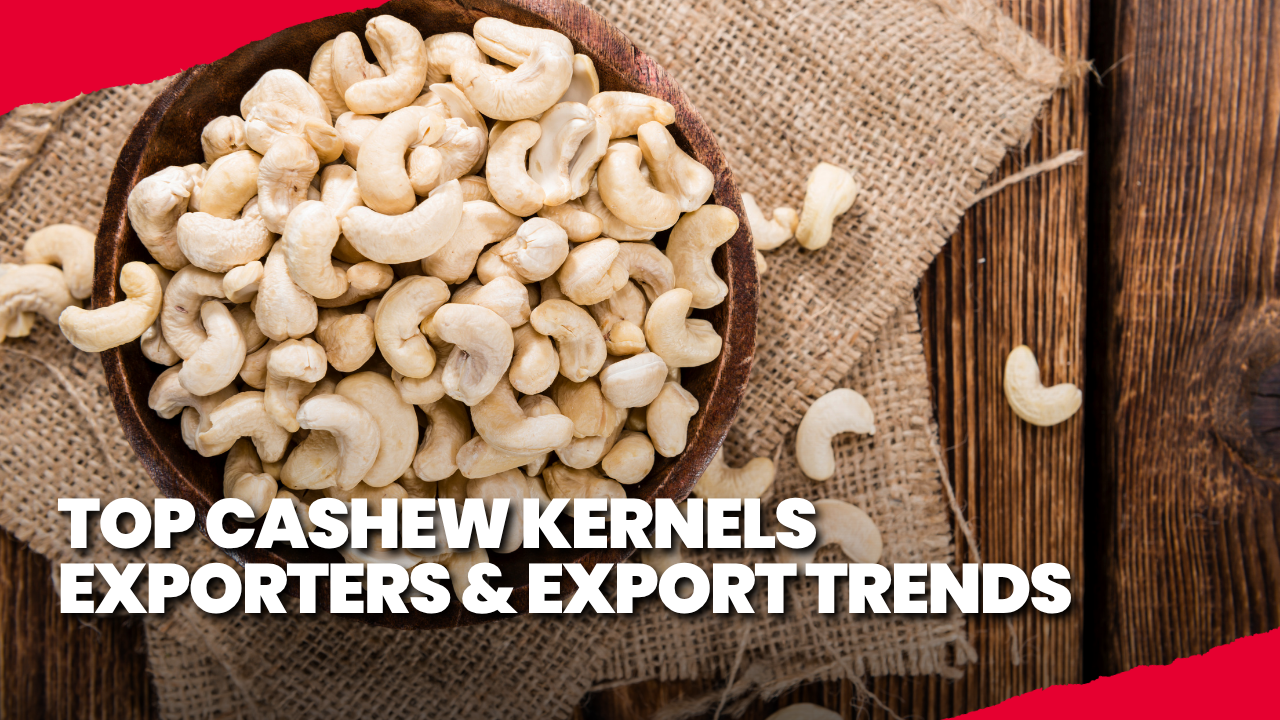
Have you ever considered why cashew prices change constantly or why some countries control the nut trade? For every bag of cashews, there is a complicated international web of farmers, processors, cashew kernels exporters, and buyers working together. One of the most traded goods in the world is cashews, which come in various forms, from raw nuts to high-quality kernels.
The trade in cashew nut export keeps growing every year, with big export hubs in Asia and Africa, and small businesses like Thai cashew nut sellers fulfilling the needs of people in the region.
It’s more important than ever for producers, traders, and even lawmakers to understand how cashew exports and imports work, since more and more people want healthy, protein-rich foods. The top countries that trade cashews, current price trends, and the opportunities that are shaping this growing business are all covered in this blog.
An Overview of Transnational Export and Import
In 2024, the average price to import raw (in-shell) cashews was USD 1,066 per ton, less than the previous year. Because of the work and processing costs, shelled (kernel) cashews are much more expensive, with an average of USD 5,685 per ton in 2024.
By value, about 62% of the world’s cashew exports are shelled seeds. The other 38% are in-shell nuts.
India sent out 68,443,500 kg of fresh or dried cashew nuts (HS 080130) worth about USD 356.5 million in trade figures in 2023. The UAE, Japan, Saudi Arabia, the Netherlands, Spain, and Vietnam were some of the most popular places to visit.
Price Overview of Cashew Nut Exports (2024)
| Cashew Type | Average Price (per ton) | Share of Global Exports |
| Raw (In-shell) | USD 1,066 | 38% |
| Shelled (Kernels) | USD 5,685 | 62% |
Biggest Cashew Nut Exporters
Some countries have strong production bases, processing facilities, or both, which makes them the world leaders in cashew exports.
- Vietnam is by far the biggest producer; its cashews make up more than 40% of the world’s total revenue from exports.
- Ivory Coast is another important manufacturer; it makes up about 15–16% of the international exports.
- India remains a prominent supplier of cashew kernels to exporters. India ships more than 15% of the worldwide production of cashews. In FY24, India’s cashew exports in kernel form were worth about USD 339.21 million.
- Ghana, the Netherlands, Nigeria, and Mozambique are other well-known producers.
These countries grow a lot of raw cashews, or they can process them in ways that make them more valuable before they are exported.
Also Read This: Why MedTech Exports Will Outpace Imports in India by 2032
Leading Cashew Nut Exporting Countries (Share of Global Exports)
| Country | Share of Global Exports | Key Strength |
| Vietnam | 40%+ | Large-scale processing |
| Ivory Coast | 15–16% | Strong raw production |
| India | 15%+ | Cashew kernels exporters |
| Ghana | ~5% | Raw nut production |
| Nigeria | ~4% | Growing exporter |
| Mozambique | ~3% | Emerging producer |
Major Cashew Nut Importers
On the other hand, some countries bring in large amounts of cashew nuts or seeds to meet their needs or to process them further.
The US bought 843.7 million USD worth of fresh or dried cashew nuts from other countries in 2023.
The UAE and Saudi Arabia still buy a lot of Indian cashews.
Europe’s Netherlands and Spain, as well as Japan, also depend on imports.
Many Asian countries, like China and Thailand, are buying more and more to process and re-export.
Leading Cashew Importing Countries (2023–2024)
| Country | Import Volume/Value | Main Suppliers |
| USA | 143.7M kg / USD 843.7M | Vietnam, Ivory Coast, Brazil |
| UAE | High kernel imports | India, Vietnam |
| Japan | Significant volumes | India, Vietnam |
| Netherlands | Major EU importer | Ghana, India, and the Ivory Coast |
| Saudi Arabia | Growing demand | India, Vietnam |
| China/Thailand | Processing + re-export | Africa & Vietnam |
Tips for Exporters and Importers
- Exporters should focus on processing food well, making sure it meets international standards for food safety, and giving unique grades like organic or specialty ones.
- To lower their risk, importers may buy from multiple suppliers, negotiate long-term contracts, and expect clear supply chains.
- New producers in Asia and Africa should combine the production of raw nuts with processing in their own countries to get more value within their own countries.
- Traders can predict price changes by keeping up with changes in tariffs and trade deals.
FAQs
In-shell cashews are raw nuts that still have their shells on. Nuts that have been processed and had their shells taken off are called shelled (kernel) exports. Because they require more work and are worth more, shelled products cost a lot more.
Adding worth and lowering bulk and weight through processing (shelling, drying, grading) makes things more profitable. Cashew kernel exporters also meet the needs of buyers who want a file ready to use.
Vietnam currently exports the most cashews, mostly the seeds, and a big chunk of the world’s trade.
Also Checkout Our YouTube Channel: @limeinstituteofexportimport






